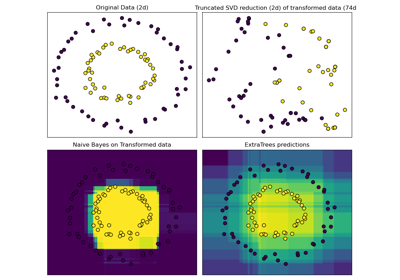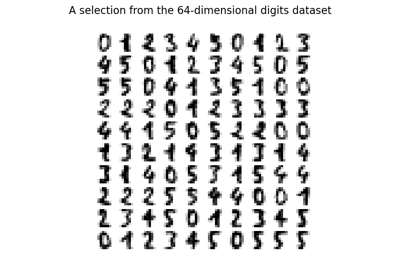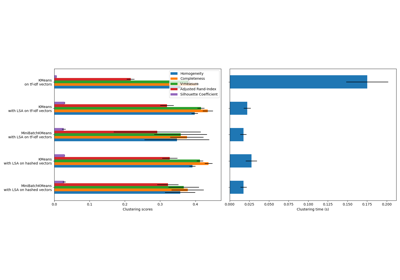TruncatedSVD#
- class sklearn.decomposition.TruncatedSVD(n_components=2, *, algorithm='randomized', n_iter=5, n_oversamples=10, power_iteration_normalizer='auto', random_state=None, tol=0.0)[source]#
Dimensionality reduction using truncated SVD (aka LSA).
This transformer performs linear dimensionality reduction by means of truncated singular value decomposition (SVD). Contrary to PCA, this estimator does not center the data before computing the singular value decomposition. This means it can work with sparse matrices efficiently.
In particular, truncated SVD works on term count/tf-idf matrices as returned by the vectorizers in
sklearn.feature_extraction.text. In that context, it is known as latent semantic analysis (LSA).This estimator supports two algorithms: a fast randomized SVD solver, and a “naive” algorithm that uses ARPACK as an eigensolver on
X * X.TorX.T * X, whichever is more efficient.Read more in the User Guide.
- Parameters:
- n_componentsint, default=2
Desired dimensionality of output data. If algorithm=’arpack’, must be strictly less than the number of features. If algorithm=’randomized’, must be less than or equal to the number of features. The default value is useful for visualisation. For LSA, a value of 100 is recommended.
- algorithm{‘arpack’, ‘randomized’}, default=’randomized’
SVD solver to use. Either “arpack” for the ARPACK wrapper in SciPy (scipy.sparse.linalg.svds), or “randomized” for the randomized algorithm due to Halko (2009).
- n_iterint, default=5
Number of iterations for randomized SVD solver. Not used by ARPACK. The default is larger than the default in
randomized_svdto handle sparse matrices that may have large slowly decaying spectrum.- n_oversamplesint, default=10
Number of oversamples for randomized SVD solver. Not used by ARPACK. See
randomized_svdfor a complete description.Added in version 1.1.
- power_iteration_normalizer{‘auto’, ‘QR’, ‘LU’, ‘none’}, default=’auto’
Power iteration normalizer for randomized SVD solver. Not used by ARPACK. See
randomized_svdfor more details.Added in version 1.1.
- random_stateint, RandomState instance or None, default=None
Used during randomized svd. Pass an int for reproducible results across multiple function calls. See Glossary.
- tolfloat, default=0.0
Tolerance for ARPACK. 0 means machine precision. Ignored by randomized SVD solver.
- Attributes:
- components_ndarray of shape (n_components, n_features)
The right singular vectors of the input data.
- explained_variance_ndarray of shape (n_components,)
The variance of the training samples transformed by a projection to each component.
- explained_variance_ratio_ndarray of shape (n_components,)
Percentage of variance explained by each of the selected components.
- singular_values_ndarray of shape (n_components,)
The singular values corresponding to each of the selected components. The singular values are equal to the 2-norms of the
n_componentsvariables in the lower-dimensional space.- n_features_in_int
Number of features seen during fit.
Added in version 0.24.
- feature_names_in_ndarray of shape (
n_features_in_,) Names of features seen during fit. Defined only when
Xhas feature names that are all strings.Added in version 1.0.
See also
DictionaryLearningFind a dictionary that sparsely encodes data.
FactorAnalysisA simple linear generative model with Gaussian latent variables.
IncrementalPCAIncremental principal components analysis.
KernelPCAKernel Principal component analysis.
NMFNon-Negative Matrix Factorization.
PCAPrincipal component analysis.
Notes
SVD suffers from a problem called “sign indeterminacy”, which means the sign of the
components_and the output from transform depend on the algorithm and random state. To work around this, fit instances of this class to data once, then keep the instance around to do transformations.References
Examples
>>> from sklearn.decomposition import TruncatedSVD >>> from scipy.sparse import csr_matrix >>> import numpy as np >>> np.random.seed(0) >>> X_dense = np.random.rand(100, 100) >>> X_dense[:, 2 * np.arange(50)] = 0 >>> X = csr_matrix(X_dense) >>> svd = TruncatedSVD(n_components=5, n_iter=7, random_state=42) >>> svd.fit(X) TruncatedSVD(n_components=5, n_iter=7, random_state=42) >>> print(svd.explained_variance_ratio_) [0.0157 0.0512 0.0499 0.0479 0.0453] >>> print(svd.explained_variance_ratio_.sum()) 0.2102 >>> print(svd.singular_values_) [35.2410 4.5981 4.5420 4.4486 4.3288]
- fit(X, y=None)[source]#
Fit model on training data X.
- Parameters:
- X{array-like, sparse matrix} of shape (n_samples, n_features)
Training data.
- yIgnored
Not used, present here for API consistency by convention.
- Returns:
- selfobject
Returns the transformer object.
- fit_transform(X, y=None)[source]#
Fit model to X and perform dimensionality reduction on X.
- Parameters:
- X{array-like, sparse matrix} of shape (n_samples, n_features)
Training data.
- yIgnored
Not used, present here for API consistency by convention.
- Returns:
- X_newndarray of shape (n_samples, n_components)
Reduced version of X. This will always be a dense array.
- get_feature_names_out(input_features=None)[source]#
Get output feature names for transformation.
The feature names out will prefixed by the lowercased class name. For example, if the transformer outputs 3 features, then the feature names out are:
["class_name0", "class_name1", "class_name2"].- Parameters:
- input_featuresarray-like of str or None, default=None
Only used to validate feature names with the names seen in
fit.
- Returns:
- feature_names_outndarray of str objects
Transformed feature names.
- get_metadata_routing()[source]#
Get metadata routing of this object.
Please check User Guide on how the routing mechanism works.
- Returns:
- routingMetadataRequest
A
MetadataRequestencapsulating routing information.
- get_params(deep=True)[source]#
Get parameters for this estimator.
- Parameters:
- deepbool, default=True
If True, will return the parameters for this estimator and contained subobjects that are estimators.
- Returns:
- paramsdict
Parameter names mapped to their values.
- inverse_transform(X)[source]#
Transform X back to its original space.
Returns an array X_original whose transform would be X.
- Parameters:
- Xarray-like of shape (n_samples, n_components)
New data.
- Returns:
- X_originalndarray of shape (n_samples, n_features)
Note that this is always a dense array.
- set_output(*, transform=None)[source]#
Set output container.
See Introducing the set_output API for an example on how to use the API.
- Parameters:
- transform{“default”, “pandas”, “polars”}, default=None
Configure output of
transformandfit_transform."default": Default output format of a transformer"pandas": DataFrame output"polars": Polars outputNone: Transform configuration is unchanged
Added in version 1.4:
"polars"option was added.
- Returns:
- selfestimator instance
Estimator instance.
- set_params(**params)[source]#
Set the parameters of this estimator.
The method works on simple estimators as well as on nested objects (such as
Pipeline). The latter have parameters of the form<component>__<parameter>so that it’s possible to update each component of a nested object.- Parameters:
- **paramsdict
Estimator parameters.
- Returns:
- selfestimator instance
Estimator instance.
Gallery examples#

Hashing feature transformation using Totally Random Trees

Manifold learning on handwritten digits: Locally Linear Embedding, Isomap…
